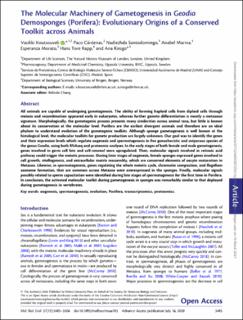| dc.description.abstract | All animals are capable of undergoing gametogenesis. The ability of forming haploid cells from diploid cells through meiosis and recombination appeared early in eukaryotes, whereas further gamete differentiation is mostly a metazoan signature. Morphologically, the gametogenic process presents many similarities across animal taxa, but little is known about its conservation at the molecular level. Porifera are the earliest divergent animals and therefore are an ideal phylum to understand evolution of the gametogenic toolkits. Although sponge gametogenesis is well known at the histological level, the molecular toolkits for gamete production are largely unknown. Our goal was to identify the genes and their expression levels which regulate oogenesis and spermatogenesis in five gonochoristic and oviparous species of the genus Geodia, using both RNAseq and proteomic analyses. In the early stages of both female and male gametogenesis, genes involved in germ cell fate and cell-renewal were upregulated. Then, molecular signals involved in retinoic acid pathway could trigger the meiotic processes. During later stages of oogenesis, female sponges expressed genes involved in cell growth, vitellogenesis, and extracellular matrix reassembly, which are conserved elements of oocyte maturation in Metazoa. Likewise, in spermatogenesis, genes regulating the whole meiotic cycle, chromatin compaction, and flagellum axoneme formation, that are common across Metazoa were overexpressed in the sponges. Finally, molecular signals possibly related to sperm capacitation were identified during late stages of spermatogenesis for the first time in Porifera. In conclusion, the activated molecular toolkit during gametogenesis in sponges was remarkably similar to that deployed during gametogenesis in vertebrates. | en_US |

